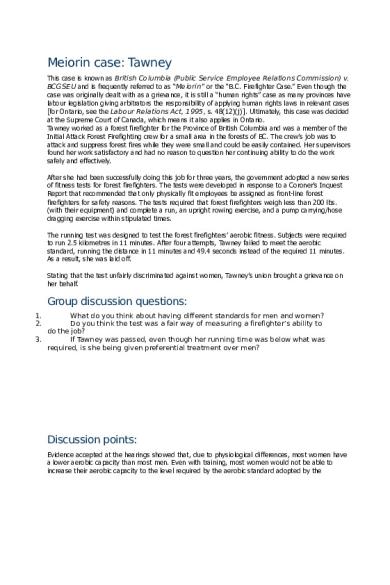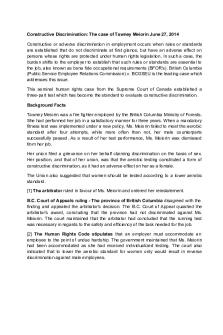Meiorin case - Case Study PDF

| Title | Meiorin case - Case Study |
|---|---|
| Author | Nguyen Ngoc |
| Course | Human Resources Mangement |
| Institution | Humber College |
| Pages | 2 |
| File Size | 50 KB |
| File Type | |
| Total Downloads | 77 |
| Total Views | 216 |
Summary
Case Study...
Description
Meiorin case: Tawney This case is known as British Columbia (Public Service Employee Relations Commission) v. BCGSEU and is frequently referred to as “Meiorin” or the “B.C. Firefighter Case.” Even though the case was originally dealt with as a grievance, it is still a “human rights” case as many provinces have labour legislation giving arbitrators the responsibility of applying human rights laws in relevant cases [for Ontario, see the Labour Relations Act, 1995, s. 48(12)(j)]. Ultimately, this case was decided at the Supreme Court of Canada, which means it also applies in Ontario. Tawney worked as a forest firefighter for the Province of British Columbia and was a member of the Initial Attack Forest Firefighting crew for a small area in the forests of BC. The crew’s job was to attack and suppress forest fires while they were small and could be easily contained. Her supervisors found her work satisfactory and had no reason to question her continuing ability to do the work safely and effectively. After she had been successfully doing this job for three years, the government adopted a new series of fitness tests for forest firefighters. The tests were developed in response to a Coroner’s Inquest Report that recommended that only physically fit employees be assigned as front-line forest firefighters for safety reasons. The tests required that forest firefighters weigh less than 200 lbs. (with their equipment) and complete a run, an upright rowing exercise, and a pump carrying/hose dragging exercise within stipulated times. The running test was designed to test the forest firefighters’ aerobic fitness. Subjects were required to run 2.5 kilometres in 11 minutes. After four attempts, Tawney failed to meet the aerobic standard, running the distance in 11 minutes and 49.4 seconds instead of the required 11 minutes. As a result, she was laid off. Stating that the test unfairly discriminated against women, Tawney’s union brought a grievance on her behalf.
Group discussion questions: 1. 2.
What do you think about having different standards for men and women? Do you think the test was a fair way of measuring a firefighter’s ability to do the job? 3. If Tawney was passed, even though her running time was below what was required, is she being given preferential treatment over men?
Discussion points: Evidence accepted at the hearings showed that, due to physiological differences, most women have a lower aerobic capacity than most men. Even with training, most women would not be able to increase their aerobic capacity to the level required by the aerobic standard adopted by the
government in this case, although training can enable most men to meet it. Evidence was also heard that 65% to 70% of male applicants pass the tests on their initial attempt, while only 35% of female applicants are successful. This was accepted as evidence of discrimination based strictly on gender, as these conditions resulted in significantly fewer women than men being employed in the particular Attack Crew that Tawney worked on. The government argued that it had done extensive research in determining the threshold levels for passing the tests. However, it was unable to convince the Court that the required aerobic capacity was really necessary for either men or women to effectively perform the work of a forest firefighter. On the contrary, because Tawney had in the past performed her work well, without apparent risk to herself, her colleagues or the public, it appeared that the test was invalid. This shows that, while physical fitness may still be a job requirement, that particular test could not adequately measure a person’s ability to perform the duties of a forest firefighter. It was suggested that if Tawney was allowed to stay in her position this might result in “reverse discrimination,” i.e., setting a lower standard for women than for men would discriminate against men who couldn’t meet the men’s standard but were nevertheless capable of meeting the women’s standard. The Court disagreed with this logic. It held that equality means to be treated according to one’s own merits, capabilities and circumstances. True equality requires that differences be accommodated; that equal treatment may require that people sometimes be treated differently. A lower aerobic standard capable of identifying women able to perform the job safely and efficiently does not necessarily imply discrimination against men. The Court decided that the aerobic standard discriminated against women. In its defence, the government then had to show that the standard was necessary to safely and effectively perform the essential job duties of a forest firefighter. This it failed to do. As a result, Tawney was given her job back and the government was given the task of finding some other non-discriminatory way of testing firefighters to assess their physical fitness as a condition of holding their job....
Similar Free PDFs

Meiorin case - Case Study
- 2 Pages

Tesco-Case-Study - Case Study
- 3 Pages

Case 9 - Case study
- 6 Pages

Case-7 - case study
- 5 Pages

Tesla Case - CASE STUDY
- 22 Pages

CASE Accenture - case study
- 3 Pages

Case 7 - Case Study
- 1 Pages

Schizophrenia. case - case study
- 4 Pages

Case Study #6 - case
- 5 Pages

Case studies - Case study
- 25 Pages

Tyco Case - case study
- 9 Pages

Gobias Case - Case Study
- 3 Pages

UBER Case - case study
- 9 Pages

Daraz.pk case case study
- 17 Pages

Beyond Meat Case - Case study
- 10 Pages
Popular Institutions
- Tinajero National High School - Annex
- Politeknik Caltex Riau
- Yokohama City University
- SGT University
- University of Al-Qadisiyah
- Divine Word College of Vigan
- Techniek College Rotterdam
- Universidade de Santiago
- Universiti Teknologi MARA Cawangan Johor Kampus Pasir Gudang
- Poltekkes Kemenkes Yogyakarta
- Baguio City National High School
- Colegio san marcos
- preparatoria uno
- Centro de Bachillerato Tecnológico Industrial y de Servicios No. 107
- Dalian Maritime University
- Quang Trung Secondary School
- Colegio Tecnológico en Informática
- Corporación Regional de Educación Superior
- Grupo CEDVA
- Dar Al Uloom University
- Centro de Estudios Preuniversitarios de la Universidad Nacional de Ingeniería
- 上智大学
- Aakash International School, Nuna Majara
- San Felipe Neri Catholic School
- Kang Chiao International School - New Taipei City
- Misamis Occidental National High School
- Institución Educativa Escuela Normal Juan Ladrilleros
- Kolehiyo ng Pantukan
- Batanes State College
- Instituto Continental
- Sekolah Menengah Kejuruan Kesehatan Kaltara (Tarakan)
- Colegio de La Inmaculada Concepcion - Cebu
